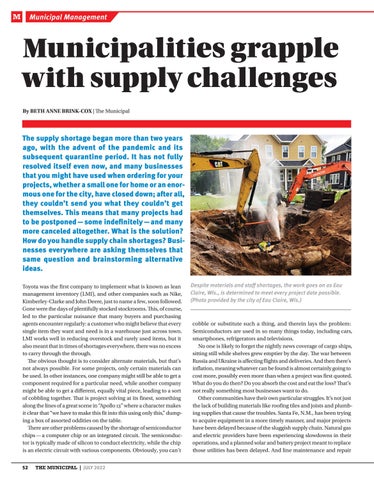M
Municipal Management
Municipalities grapple with supply challenges By BETH ANNE BRINK-COX | The Municipal
The supply shortage began more than two years ago, with the advent of the pandemic and its subsequent quarantine period. It has not fully resolved itself even now, and many businesses that you might have used when ordering for your projects, whether a small one for home or an enormous one for the city, have closed down; after all, they couldn’t send you what they couldn’t get themselves. This means that many projects had to be postponed — some indefinitely — and many more canceled altogether. What is the solution? How do you handle supply chain shortages? Businesses everywhere are asking themselves that same question and brainstorming alternative ideas. Toyota was the first company to implement what is known as lean management inventory (LMI), and other companies such as Nike, Kimberley-Clarke and John Deere, just to name a few, soon followed. Gone were the days of plentifully stocked stockrooms. This, of course, led to the particular nuisance that many buyers and purchasing agents encounter regularly: a customer who might believe that every single item they want and need is in a warehouse just across town. LMI works well in reducing overstock and rarely used items, but it also meant that in times of shortages everywhere, there was no excess to carry through the through. The obvious thought is to consider alternate materials, but that’s not always possible. For some projects, only certain materials can be used. In other instances, one company might still be able to get a component required for a particular need, while another company might be able to get a different, equally vital piece, leading to a sort of cobbling together. That is project solving at its finest, something along the lines of a great scene in “Apollo 13” where a character makes it clear that “we have to make this fit into this using only this,” dumping a box of assorted oddities on the table. There are other problems caused by the shortage of semiconductor chips — a computer chip or an integrated circuit. The semiconductor is typically made of silicon to conduct electricity, while the chip is an electric circuit with various components. Obviously, you can’t 52 THE MUNICIPAL | JULY 2022
Despite materials and staff shortages, the work goes on as Eau Claire, Wis., is determined to meet every project date possible. (Photo provided by the city of Eau Claire, Wis.)
cobble or substitute such a thing, and therein lays the problem: Semiconductors are used in so many things today, including cars, smartphones, refrigerators and televisions. No one is likely to forget the nightly news coverage of cargo ships, sitting still while shelves grew emptier by the day. The war between Russia and Ukraine is affecting flights and deliveries. And then there’s inflation, meaning whatever can be found is almost certainly going to cost more, possibly even more than when a project was first quoted. What do you do then? Do you absorb the cost and eat the loss? That’s not really something most businesses want to do. Other communities have their own particular struggles. It’s not just the lack of building materials like roofing tiles and joists and plumbing supplies that cause the troubles. Santa Fe, N.M., has been trying to acquire equipment in a more timely manner, and major projects have been delayed because of the sluggish supply chain. Natural gas and electric providers have been experiencing slowdowns in their operations, and a planned solar and battery project meant to replace those utilities has been delayed. And line maintenance and repair
















